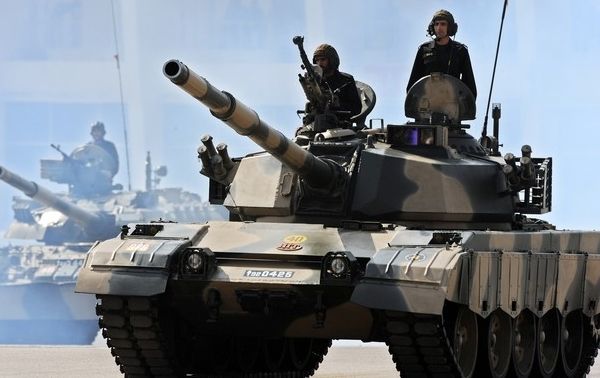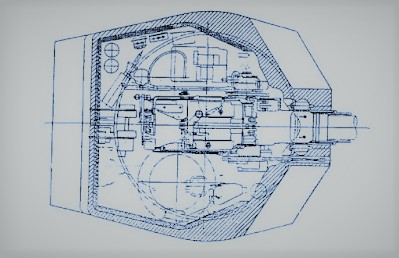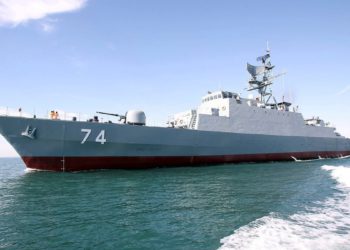Background:
The Al Khalid series is Pakistan’s most modern and capable tank in its inventory. Pakistan, wishing to acquire a more modern armored force, agreed to jointly co develop and produce a tank, loosely based on the Chinese Type-90 with China in late 1990. Pakistan began building a new tank factory in 1992 with the aim to produce the tank as soon as development was complete. With the assistance of China and Ukraine, the joint effort began designing and testing with anticipated deliveries set for the early 2000’s timeframe. This ambitious project officially turned into reality in 2001, with the first production variants coming on line for the Pakistani Army. The design requirements are predicated on the need for Pakistan to possess parity with the Indian Army and also potential threats from their western border. In this requirement, the vehicle must offer lethal direct fires and possess tactical mobility which the Army needs in order to rapidly implement defensive operations as a result of Pakistan lacking critical strategic geographical depth.

The design is intended to make up for Pakistan’s financial constraints and is therefore based off of proven and well sourced end item components. Further, the design was focused on operating in extremely harsh and hot environments found in Pakistan’s desert and border region with India. Special attention was paid to sustainment costs associated with operational use. This was due to the fiscal factors that it would not be procured in bulk to equip the entirety of the Army’s tank units. The design was to be modular in nature and be able to take advantage of the lineage of its design, such as with its origins in Chinese tank design, as well as with Russian tank designs. The design parameters were for a 3 man crew with an engine power turn out at a base of 1,200 hp. It was to weigh no more than 50 tons and must retain commonality with in use inventories and production lines, found in service with other programs. This provides for sustained logistics chain and vendor options externally, if organic means of production were to be interrupted. Lastly, Pakistan selected it’s in service 125mm main gun with domestic production of ammunition and barrel, which is based off of a modified Chinese origin.
Program Vision and Overview:
The Al Khalid will remain in Pakistani service for years to come and will be supplemented by the Chinese VT–4, itself a further evolution of the Chinese Type 90 and Al Khalid tank family. The Al Khalid and its improved version, has a design that places significant attention towards tactical mobility and firepower and is designed to counter rapid armored attacks from regional ground based threats, notably found in the Cold Start Doctrine. Further, modern communication equipment, to include real time data links, have been installed, to provide for a robust C2 interface for tank units. The tank was designed to deliver lethal and accurate fire at a range estimated at 2,000 meters with its main gun and out to an estimated 5,000 meters with its tube launched AT–11 origin ATGM. The Al Khalid is not intended to serve purely as an armor stop gap option, it is intended, as well as improved models, to serve as the mainstay of the force, with incremental changes and production, which will over time, modernize and replace obsolescent tanks currently in service. The industrial growth for its State owned company, Heavy Industries Taxila, requires continued orders which will allow for more enhanced and modernized vehicles to be designed and procured. The ultimate goal for the program is to reinforce and strengthen domestic self-reliance and production capability. The design is capable of being deployed and transported by rail, sea, waterway and road modes of transportation. It has a top end weight of 47 tons. The vehicle is designed to be survivable against current direct fire weapon systems and operate in CBRN environments.
Lethal formations:
The tank possess digital automotive functions to support training, mission preparation and execution, which facilitate tactical employment. The tank possesses situational awareness and target acquisition capabilities to orient and deliver direct fires on enemy forces. The tank employs a battle management system and has the ability to receive data downloads from aerial assets in a non-contested environment. Pakistani armored doctrine focuses on rapid deployments to occupy battle positons. The vehicle can also provide direct support to infantry units with its 125mm main gun by using HE-Frag munitions. The tank also possesses sufficient thermals and a fire control system that allows for engagements in all weather conditions and while on the move. It is estimated to possess DRI capabilities, with identification ranges rated at or around 5km on the newest models as a result of improved capabilities gain through foreign assistance.
Due to the electronics, fire control system and thermal viewing capability of vehicle, Defensionem assesses that the tank will provide lethal direct fires against armored threats at ranges in excess of 2,000 meters. The vehicle uses a 125mm smoothbore cannon that can fire all indigenous, Chinese and some Soviet bloc rounds, as well as tube launched ATGM’s. The standard anti-armor round is a depleted uranium sabot round, commonly known as the Naiza, which is made by the state owned National Defense Complex, the primary provider of Pakistan’s depleted uranium munitions. This specific round was initially developed for use by Pakistan in their Ukrainian imported T-80UD models. This round has similarities to aforementioned former Soviet bloc munitions, notably the 3BM48 Svinets, and is assessed as being a close variant made by Pakistan. It is deemed probable that the round is equivalent to the 3BM48, with modifications made to the penetrator rod, alloys, as well as propellant for better ballistic performance. Engagement ranges with this round are assessed as being under 2,000m against modern tanks with composite and reactive armor. Engagement ranges towards an enemy side or rear are likely to obtain more favorable results and at greater distances. Subsequently, an improved round, with different design features is currently in the works and is anticipated to be based on Chinese designs associated with their Type 99 series.

Vehicle Vulnerability Analysis
Defensionem assess via use of a fault tree analysis that cover the main subsystems that, if damaged or destroyed, would cause a communication, mobility, lethality, or catastrophic kill. These types of kills are defined below.
Communications Kill
The vehicle experiences a communications-kill if it is damaged to the extent that it cannot transmit or receive information by its electronic communication equipment, and the damage is not repairable by the crew on the battlefield within 10 minutes. The Al Khalid benefits from employing an integrated communication system that is mounted under the turret’s ballistic protection. The probability of a communications kill occurring is rated as low. Standard vulnerability to radio antennas are present and communication attachments mounted on the turret roof.
Mobility Kill
The vehicle experiences a mobility-kill if the damage causes the vehicle to be incapable of performing any of the mobility requirements of its assigned mission, and the damage is not repairable by the crew on the battlefield within 20 minutes. The Khalid series is designed with an APS system and has ERA applied. Further models have side skirts with ballistic tendencies. The tank is equipped with anti-missile jammers and other self-defense sub systems that further aid in mitigating enemy anti-tank missiles. These factors decrease the probability of a mobility kill. Probability is rated as moderate, as a result of the vehicle possessing a moderate coverage of ERA along the front and sides, as well as limited ballistic skirt protection.

Lethality Kill
The vehicle experiences a lethality-kill if the damage causes the vehicle to be incapable of performing any of the lethality requirements of its assigned mission, and the damage is not repairable by the crew on the battlefield within 10 minutes. The Khalid serieshas a 125mm cannon and also a 12.7mm weapon system. Due to the lighter weight of the vehicle and limited armor along the gun mount, the vehicle, has inherently more vulnerability along its frontal portions of the turret compared to most modern vehicles. The design does not employ an integrated armor protection scheme along the gun mantle, increasing vulnerability. The chances of a lethality kill occurring is assessed as moderate and trends high in earlier variants. Further, due to the lighter weight of the turret, which absorbs direct fire impacts, dissipating the transferred energy, critical components such as the FCS and or gunners sights are deemed at higher than normal risk to damage, especially to its bi axis and dual gyro stabilization components. While the tank also employs a hydraulic turret with aux pump, the smaller size of the turret and ballistic protection for the pump remain vague, it is therefore assessed that lethality kills can occur, as with most tanks with this design lineage, if hit by non KE rounds within the quadrant locating either the main gun or the aux pump.
It is unknown if the vehicle has auxiliary power unit for extended use, but according to technical specifications, there does not seem to be an increase of stowage on the chassis or turret for one. Therefore it is deemed as unlikely. The loss of the battery compartment will also enable a lethality kill. The 12.7mm weapon station is mounted, elevated and suffers from the standard risk of damage from fragments, small arms fire or a main gun rounds impacting. Additionally, the weapon station is mounted in front of the Tank Commander, affording the crew member some level of protection while repairing and or reloading the machine gun. The probability of the secondary weapons being damaged is deemed moderate to high.
Catastrophic Kill (K-kill)
The vehicle suffers a catastrophic-kill if the damage is so extensive that the vehicle is not economically repairable. Items carried on-board the vehicles whose detonation or ignition could result in catastrophic damage would be items such as ammunition, fuel, oil, fluids, etc. The Al Khalid series has a mixed layer of protection, with several approaches to mitigate risk. The tank’s basic armor is made of steel, with composite armor and ERA added to the protection scheme. Additionally, the Khalid has an APS integrated and fit to the vehicle. The modular armor package consists a layered application of steel platesencapsulating composite armor, which absorbs and reduces penetration. This package can also be changed out under battlefield conditions. The overall armor package is complemented by an internally hardened wall to further reduce penetration effects. Further, due to the design, the tank presents a smaller silhouette further aiding in protection.

Another survivability and defense component of the vehicle is its integrated warning system that alerts the crew to being targeted and provides counter measures for employment. Future variants are anticipated to employ Chinese armor designs and feature a layered, semi wedge like front, as it is expected that the armor protection scheme is modeled after the Chinese and their Type-99 series tank. The Khalid’s use of modular armor presents a significant survivability concern, as the modular package does not offer significant protection to the flanks and to the gun mantle. Due to the small design of the turret, the requirement for additional supplemental armor is critically needed and afforded through the addition of an ERA package, developed in Pakistan, and assessed as being equivalent to Kontak-5 ERA with local modifications for specific use. Assessing the detailed production schematics of the vehicle and the ERA packages, it is also further concluded that the design most likely originates from Soviet era pedigree. Additionally, as with all mounted armor modules. They must be fitted into pre manufactured positions and are not integrated as a single package. This causes a lower collective resistance to any penetrating munition, as the entirety of the package consists two separate components. Due to the dimensions of the turret design and analysis of its weight, Defensionem estimates the Al Khalid and the initial improved variant, has an estimated RHA equivalency of close to 560mm over the frontal arch of the turret. The operational environment found in Pakistan consists of wide flat deserts, with intermediate IV lines and depressions, to more constricted terrain north towards Lahore. Due to the large population in relation to small geographical space, ground transit options will be further restrictive, more so if the population needs to displace due to an oncoming enemy force. These factors also play into the likely employment of the vehicle. The design focused on tactical mobility with a low silhouette, while being armed with sufficient firepower. It is probable that the tank can reach some levels of parity with Indian armor vehicles and is likely to be superior to Iranian armor vehicles. Engagement scenarios further lead to speculation on how terrain and coordination with other Army formations would play out. Assessing the totality of the circumstances, this tank is meets the technical requirements laid out by the Pakistani Army and supports Pakistan’s defense industrial growth.










